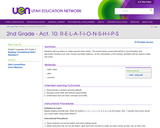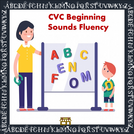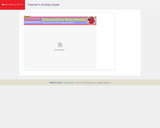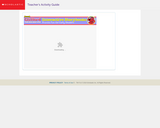
In this lesson, students will use letters to make several short words.
- Subject:
- English Language Arts
- Material Type:
- Lesson Plan
- Provider:
- Utah Education Network
- Author:
- Utah Education Network
- Date Added:
- 04/23/2018

In this lesson, students will use letters to make several short words.

This resource accompanies our Rethink 2nd Grade ELA course. It includes ideas for use, ways to support exceptional children, ways to extend learning, digital resources and tools, tips for supporting English Language Learners and students with visual and hearing impairments. There are also ideas for offline learning.

This parent guide supports parents in helping their child at home with the 2nd Grade English Language Arts content. Within the folder you will access Parent Guide PDFs in FIVE Languages: Arabic, English, Hindi, Spanish, and Vietnamese to help on-going communication with caregivers.

In this lesson, students will learn how to figure out a tricky word by trying out both sounds of the vowel and listening to see which word sounds right or makes sense. This lesson is part of the 'Unit of Study: Monitoring for Meaning: Using Multiple Strategies to Decode' and is found on page 38.

This lesson is for Grades 1 - 2 on literacy. At Home Learning Lessons are a partnership between the North Carolina Department of Public Instruction, PBS North Carolina, and the William and Ida Friday Institute for Educational Innovation. Each lesson contains a video instructional lesson, a PDF lesson plan with a transcript, and a PDF file of extension activities.

This lesson is for Grades 1 - 2 on literacy. At Home Learning Lessons are a partnership between the North Carolina Department of Public Instruction, PBS North Carolina, and the William and Ida Friday Institute for Educational Innovation. Each lesson contains a video instructional lesson, a PDF lesson plan with a transcript, and a PDF file of extension activities.

This lesson is for Grades 1 - 2 on literacy. At Home Learning Lessons are a partnership between the North Carolina Department of Public Instruction, PBS North Carolina, and the William and Ida Friday Institute for Educational Innovation. Each lesson contains a video instructional lesson, a PDF lesson plan with a transcript, and a PDF file of extension activities.

This lesson is for Grades 1 - 2 on literacy. At Home Learning Lessons are a partnership between the North Carolina Department of Public Instruction, PBS North Carolina, and the William and Ida Friday Institute for Educational Innovation. Each lesson contains a video instructional lesson, a PDF lesson plan with a transcript, and a PDF file of extension activities.

This lesson is for Grades 1 - 2 on literacy. At Home Learning Lessons are a partnership between the North Carolina Department of Public Instruction, PBS North Carolina, and the William and Ida Friday Institute for Educational Innovation. Each lesson contains a video instructional lesson, a PDF lesson plan with a transcript, and a PDF file of extension activities.

Students engage in games and chants to recognize the same sounds in different words. Students match objects with the same beginning or ending sound, identify whether a given sound occurs at the beginning or ending of a word, and connect phonemes with graphemes.

This resource supports students' ability to identify letters and letter sounds. Visuals are provided as guidance as well.

Students can practice their reading skills as they read stories with high-frequency words; interact with the computer to create new text; understand that changing one word in a sentence can change the meaning of the entire sentence; recognize consonant sound-spellings; distinguish easily confused letter pairs; and recognize common short and long vowel sounds as they participate in this interactive reading of Clifford's beloved stories.

Students can practice their reading skills as they read stories with high-frequency words; interact with the computer to create new text; understand that changing one word in a sentence can change the meaning of the entire sentence; recognize consonant sound-spellings; distinguish easily confused letter pairs; and recognize common short and long vowel sounds as they participate in this interactive reading of Clifford's beloved stories.

Students will have to listen carefully so they can match words that have the same middle vowel sound, like "stove" and "rose."

After the lesson of explaining the reading and spelling for oi/oy, give some example words, cold call on students to read sentences that have oi/oy words in them, and ask students to come up with some oi/oy words to add to the list.
Students cut apart provided words. Teacher guides students to group similar words together. If necessary, teacher prompts with "Notice how the words look" and/or "Notice how the words sound."
For an extension, students could also create subgroups by sorting according to where the letter combination is found in the word-at the beginning, middle, or end.
It is suggested that an anchor word for each combination be added to a resource such as a word wall or word study notebook for future reference.
For assessment, students could sort and glue into the groups, read the list of words from the sort, or spell the words from the sort.

Students write the comparative form for the adjectives shown.

This lesson is for grades 1-2 on literacy. At Home Learning Lessons are a partnership between the North Carolina Department of Public Instruction, PBS North Carolina, and the William and Ida Friday Institute for Educational Innovation. Each lesson contains a video instructional lesson, a PDF lesson plan with a transcript, and a PDF file of extension activities.

This lesson is for grades 1-2 on literacy. At Home Learning Lessons are a partnership between the North Carolina Department of Public Instruction, PBS North Carolina, and the William and Ida Friday Institute for Educational Innovation. Each lesson contains a video instructional lesson, a PDF lesson plan with a transcript, and a PDF file of extension activities.

This is a digital anchor chart.

This worksheet asks students to circle the number of syllables for each word.